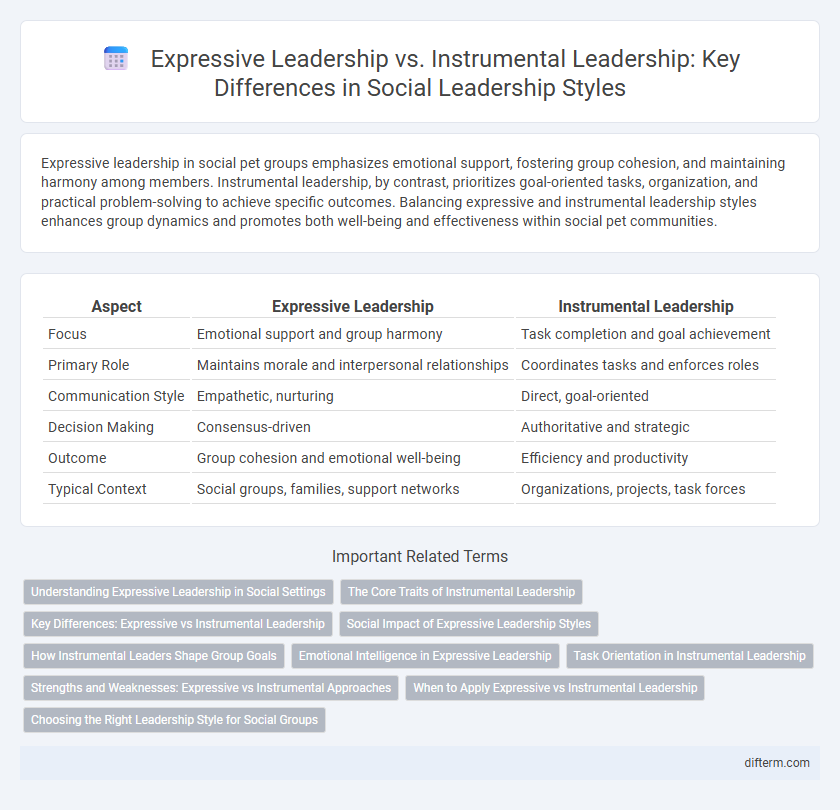Expressive leadership in social pet groups emphasizes emotional support, fostering group cohesion, and maintaining harmony among members. Instrumental leadership, by contrast, prioritizes goal-oriented tasks, organization, and practical problem-solving to achieve specific outcomes. Balancing expressive and instrumental leadership styles enhances group dynamics and promotes both well-being and effectiveness within social pet communities.
Table of Comparison
| Aspect | Expressive Leadership | Instrumental Leadership |
|---|---|---|
| Focus | Emotional support and group harmony | Task completion and goal achievement |
| Primary Role | Maintains morale and interpersonal relationships | Coordinates tasks and enforces roles |
| Communication Style | Empathetic, nurturing | Direct, goal-oriented |
| Decision Making | Consensus-driven | Authoritative and strategic |
| Outcome | Group cohesion and emotional well-being | Efficiency and productivity |
| Typical Context | Social groups, families, support networks | Organizations, projects, task forces |
Understanding Expressive Leadership in Social Settings
Expressive leadership emphasizes emotional support, group harmony, and interpersonal relationships to maintain social cohesion within a group. This leadership style fosters trust, empathy, and open communication, which enhances group morale and collective well-being. In social settings, expressive leaders prioritize the emotional needs of members over task completion, creating a supportive and inclusive environment.
The Core Traits of Instrumental Leadership
Instrumental leadership is defined by goal-oriented traits such as decisiveness, task focus, and efficiency, ensuring clear direction and measurable outcomes. Leaders exhibiting these core qualities prioritize structure, organization, and practical solutions to achieve objectives effectively. This style contrasts with expressive leadership by emphasizing control and task completion over emotional support and group cohesion.
Key Differences: Expressive vs Instrumental Leadership
Expressive leadership prioritizes emotional support, nurturing group cohesion, and maintaining morale, which enhances interpersonal relationships within social groups. Instrumental leadership, by contrast, focuses on goal attainment, task organization, and efficiency, driving structured decision-making and performance outcomes. Key differences lie in their core functions: expressive leaders cultivate belonging and harmony, while instrumental leaders emphasize strategy, roles, and productivity.
Social Impact of Expressive Leadership Styles
Expressive leadership significantly enhances group cohesion and emotional well-being by prioritizing interpersonal relationships and supporting team members' needs. This leadership style fosters a collaborative culture that leads to increased social capital and collective efficacy within communities. Organizations embracing expressive leadership often experience higher volunteer engagement and stronger social networks, amplifying their overall social impact.
How Instrumental Leaders Shape Group Goals
Instrumental leaders drive group goals by organizing tasks, setting clear objectives, and allocating resources to ensure efficiency and productivity. They focus on achieving specific outcomes through structured planning and coordination, which enhances group performance and goal attainment. Their pragmatic approach aligns team efforts with measurable results, fostering a goal-oriented environment.
Emotional Intelligence in Expressive Leadership
Expressive leadership emphasizes emotional intelligence by fostering empathy, social awareness, and effective communication within groups, which enhances team cohesion and emotional support. Leaders with high emotional intelligence in expressive roles navigate interpersonal dynamics sensitively, promoting psychological safety and collaboration. This contrasts with instrumental leadership that prioritizes task completion and goal achievement over emotional connection.
Task Orientation in Instrumental Leadership
Instrumental leadership emphasizes task orientation by prioritizing goal achievement and clear structure to ensure efficiency and productivity. Leaders adopting this style focus on organizing tasks, establishing roles, and monitoring performance to meet specific objectives. This approach contrasts with expressive leadership, which centers on group cohesion and emotional support rather than strict task management.
Strengths and Weaknesses: Expressive vs Instrumental Approaches
Expressive leadership excels in fostering group cohesion and emotional support, enhancing morale and interpersonal relationships, but may struggle with task efficiency and decision-making under pressure. Instrumental leadership prioritizes goal achievement, structured planning, and task completion, which can increase productivity but often at the expense of group emotional needs and harmony. Balancing these approaches is critical, as over-reliance on one may weaken overall leadership effectiveness in dynamic social environments.
When to Apply Expressive vs Instrumental Leadership
Expressive leadership is most effective in fostering group cohesion and managing emotional dynamics during times of stress or conflict, enhancing team morale and social support. Instrumental leadership is best applied when clear direction, goal-setting, and task completion are priorities, emphasizing structure, efficiency, and performance outcomes. Understanding group needs and situational demands helps leaders choose expressive approaches for emotional stability or instrumental strategies for achieving specific objectives.
Choosing the Right Leadership Style for Social Groups
Expressive leadership excels in fostering group cohesion and emotional support, making it ideal for social groups that prioritize harmony and interpersonal relationships. Instrumental leadership emphasizes task completion and goal achievement, which suits groups focused on structured objectives and efficiency. Selecting the appropriate leadership style depends on the social group's primary needs, whether nurturing collaboration or driving performance.
expressive leadership vs instrumental leadership Infographic

 difterm.com
difterm.com